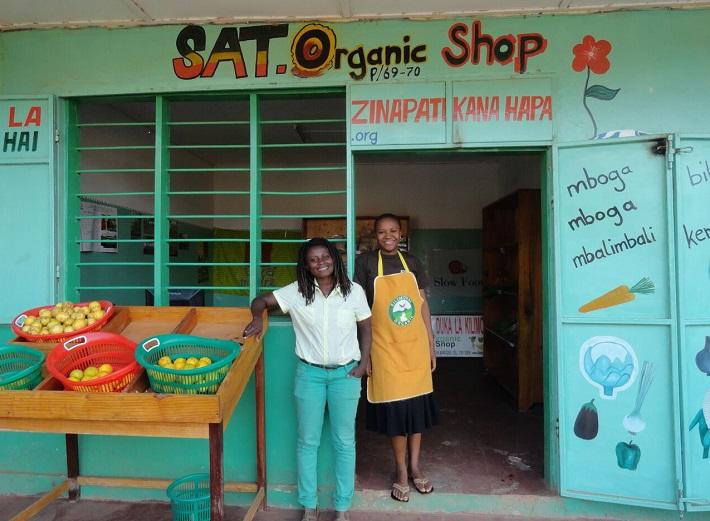Ask the innovators: Which agricultural practices work best locally?

A new study by Bioversity International explores the power of ‘positive deviance’ in Tanzania. By working with highly successful farmers, this methodology identifies locally proven practices that other farmers from the same area can benefit from.
Like most residents of Mchengamoto, a Tanzanian village not far from the border with Mozambique, Ms Mariam Ally occasionally sells poultry to the traders who pass the area. A while ago, however, the 33-year-old farmer had a unique idea to make the most out of her small-scale production. She installed a small solar panel to the coop's roof: a light bulb now extends the light of day for the chickens, causing them to eat more and fatten more quickly. The increased sales soon repaid her initial investment.
Mariam Ally is a 'positive deviant.' She was part of a recent study, led by Bioversity International and funded by the UK Department for International Development (DFID), which addressed a challenge often faced by agricultural development organizations around the world: which practices should be promoted to farmers? Often, innovations that worked well elsewhere are not widely adopted by the target farmers of a development programme because, for example, they do not fit with the local culture or have been showing unexpected downsides in the new context.

Credit: Bioversity International/J. Steinke
The 'Positive deviance approach'
The 'Positive deviance approach' takes a different perspective to selecting promising practices. The concept, originally developed in the 1990s to identify good child care practices in Asia, is simple. The grass isn’t always greener on the other side. And yet, somebody in the village has the greenest grass, despite facing the same challenges as others. So, what can be learnt from that high performer?
In all rural communities, there are some farmers who are creative and apply innovative practices, achieving better outcomes. With the Positive Deviance approach, research focuses on farmers whose farm and development performance seem to stick out from the crowd.
Working with these individuals, there is a high chance of observing locally viable, innovative practices that already contribute to intensified production despite existing local constraints. These practices, just like Ms Ally's solar coop lamp, can be a suitable option for other farmers working in the same area, with similar resource levels and environmental conditions.
The approach in action
Through a quantitative survey, Bioversity International’s researchers collected data from over 500 farming households in southern Tanzania on, for example, the farming system, income or dietary habits. Then, they identified households with outstanding performance and visited some of these positive deviants for farm observations and in-depth interviews, to spot uncommon, innovative behaviors.
But what is ‘performance’ anyway? Farming is a whole way of life, requiring complex decisions about scarce household resources and competing goals. Farmers need to produce food for the household, generate some income, and preserve natural resources, all at the same time.
If the definition of ‘positive deviance’ focused exclusively on the most productive households, that might lead to innovative practices with adverse implications, for example, for household income or the environment. To avoid identifying such unsustainable practices, the study defined positive deviants by exceptionally strong overall performance for five key targets of development: Food security, Income, Nutrition, Environmental sustainability, and Social equity.

Identifying locally viable options for agricultural development
But does this approach not risk simply identifying the wealthiest farmers, with largest farms or best market access, as positive deviants? By accounting for individual household resources, the researchers put performance into perspective: the selection criterion for being a positive deviant was achieving better outcomes than other households with equivalent resource endowments. That is, positive deviants performed better than expected.
Mariam Ally, the entrepreneurial farmer from Mchengamoto, was but one of 15 rural household leaders visited by the research team. All in all, the interviews and farm visits revealed a list of 14 promising practices that likely contributed to these households’ superior achievements. Positive deviants engaged in a large diversity of innovative practices: from agronomic improvements, such as pulse-cereal intercropping, to on-farm businesses, such as a tree nursery, to off-farm enterprises, such as a private transportation business.
Once identified, the innovative practices can be promoted to other households facing similar challenges. This new method can help policymakers plan development interventions at household level that are well-grounded in local contexts.
In their study, the authors draw three main conclusions:
- Positive deviants were diverse with respect to resource endowments and livelihood activities. Exploring the behaviours of these heterogeneous households generated a wide range of locally viable household-level practices that may support sustainable agricultural development in diverse contexts.
- Identifying such locally viable practices does not require complex econometric modelling or extensive qualitative fieldwork. Rather, an efficient combination of quantitative and qualitative research methods makes the Positive Deviance approach scalable and accessible for local development agencies, such as NGOs.
- The performance differences between positive deviants and other households also indicated most-promising domains for development interventions. In the case of southern Tanzania, the study suggests highest potential for improvements in food security and income. Improvements in nutrition and social equity, for example, seem harder to achieve without repercussions for other dimensions.
This research is conducted as part of the CGIAR Research Program on Roots, Tubers and Bananas (RTB), and is supported by contributors to the CGIAR Trust Fund.
In particular, this initiative has been funded by UK aid from the UK Government, through the Sustainable Agricultural Intensification Research and Learning in Africa (SAIRLA) programme.
